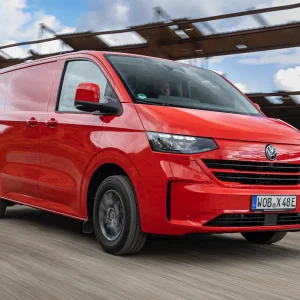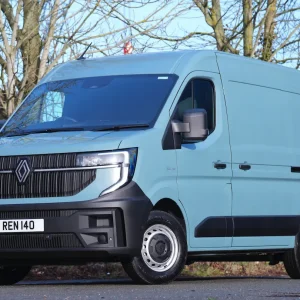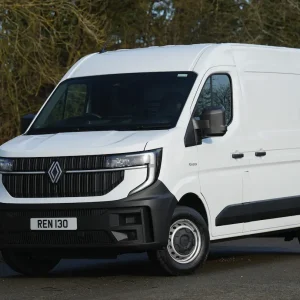Mercedes-Benz has come up with a variety of different technologies that will either help you get more out of your existing diesel vehicle, or persuade you to switch to a different power source. Watching the size of its carbon footprint ever so carefully, What Van? went to Hamburg in Germany to sample them.
ECO Start
 One of the first we got to grips with is ECO Start. Not a new idea, but none the worse for that, it kills the engine every time you’re idling pointlessly in traffic, or ticking over at the lights. To start the engine and move away, all you need to do is depress the clutch and slip the gearstick into first at the same time.
One of the first we got to grips with is ECO Start. Not a new idea, but none the worse for that, it kills the engine every time you’re idling pointlessly in traffic, or ticking over at the lights. To start the engine and move away, all you need to do is depress the clutch and slip the gearstick into first at the same time.
We had a quick run round Hamburg docks in a Sprinter equipped with ECO Start. Initially the system is a bit disconcerting — in a reflex action you automatically try to restart the engine with the ignition key every time it stops — but you soon get used to it and there’s no denying that it works well.
Mercedes reckons that operators can achieve a fuel saving of from five to eight per cent by specifying ECO Start, rising as high as 20 per cent in one or two cases. It’s up for grabs on all Sprinters powered by a four-cylinder diesel married to a manual transmission and will set you back £545. In our view it’s well worth it.
Gas, Naturally
 Due for launch on this side of the Channel in 2009 — the price was unavailable at the time of writing — the Sprinter 316 NGT represents a different approach to cutting fuel bills. Powered by a 156hp 1.8-litre engine, it will run on either petrol or compressed natural gas (CNG). While the latter’s energy content is lower than that of mainstream automotive fuels, it’s cheaper, and Mercedes reckons that the newcomer’s operating costs are up to 30 per cent lower than those of a diesel Sprinter.
Due for launch on this side of the Channel in 2009 — the price was unavailable at the time of writing — the Sprinter 316 NGT represents a different approach to cutting fuel bills. Powered by a 156hp 1.8-litre engine, it will run on either petrol or compressed natural gas (CNG). While the latter’s energy content is lower than that of mainstream automotive fuels, it’s cheaper, and Mercedes reckons that the newcomer’s operating costs are up to 30 per cent lower than those of a diesel Sprinter.
It’s a calculation that includes subsidies for operators who purchase such vehicles, however; not something you see in Britain these days, although subsidies continue to be offered in certain other markets. So far as the UK is concerned, the other big problem is CNG’s availability. You’ll need to have your own source of supply because the vast majority of forecourts don’t sell it.
Another foray around the docks revealed a van that runs quietly, packs plenty of punch thanks to all those horses and doesn’t miss a beat when you flick a button on the dashboard to switch it from petrol to CNG and back again. There’s no discernible difference in the performance offered by the two fuels and the CNG tank is mounted beneath the floor, keeping the load area clear. However, it adds over 170kg to Sprinter’s weight along with the ancillary equipment required.
Plug-In Hybrid
 The third Sprinter we tried is unlikely to be produced in volume for a little while yet. Grossing at 3.88 tonnes, it’s the Sprinter Plug-In Hybrid. Equipped with a, for most applications excessively powerful, 258hp 3.5-litre petrol engine and an electric motor with an output of up to 71kW, it can travel up to 30km at a stretch on battery power alone. The two power sources are blended as and when required, with both coming into play when a powerful burst of acceleration is needed.
The third Sprinter we tried is unlikely to be produced in volume for a little while yet. Grossing at 3.88 tonnes, it’s the Sprinter Plug-In Hybrid. Equipped with a, for most applications excessively powerful, 258hp 3.5-litre petrol engine and an electric motor with an output of up to 71kW, it can travel up to 30km at a stretch on battery power alone. The two power sources are blended as and when required, with both coming into play when a powerful burst of acceleration is needed.
The lithium-ion batteries are recharged by the engine while the vehicle is on the move through regenerative braking, and by plugging them into the mains either overnight or while the driver is on his break.
Is fuel saved? Trials of diesel Sprinter hybrids in both France and the USA have resulted in cuts in usage of 40 per cent and 36 per cent respectively replies Mercedes. A more extensive trial involving 11 of the petrol hybrids will be held in the USA later this year; hence the petrol engine and the automatic gearbox.
Trickling around a congested dockland at low speeds, the Sprinter was eerily quiet; so quiet that we felt that there ought to be some means of warning pedestrians of its approach. The engine cuts in seamlessly whenever it is needed and fades away when necessary just as discreetly. Swap the petrol engine for a frugal diesel and you could find you are looking at pretty much the ideal tool for city centre delivery runs.
Although the battery pack weighs 175kg, a 1,600kg payload capacity is nonetheless respectable, and the pack doesn’t intrude into the cargo bay.
Diesel
Vehicles such as the Sprinter Plug-In Hybrid do not, however, represent Mercedes-Benz’s sole response to the oil crisis. It reckons the humble diesel engine still has a lot of unrealised potential, with common rail injection pressures of up to 2,000 bar a possibility in the near future. Equipped with directly-driven electronic injectors, the next generation of diesels will burn fuel even more efficiently than today’s powerplants, it predicts; just as well given that, along with the pressure on oil resources, sheer lack of refinery capacity is pushing up diesel price.
SunDiesel
Widely accused of helping to drive up world food costs because much of the land that grows the plants used to produce it could allegedly be turned over to cereals instead, biodiesel has been under fire in recent months.
Mercedes believes that mixing something called Biomass-To-Liquid with ordinary diesel has a lot of potential. It’s made from industrial crops, but in this case the entire plant is used — not always the case with biodiesel — and mixed in with, for example, waste from sawmills. The result is an annual yield of some 4,000 litres of SunDiesel a hectare; about three times more than the figure for biodiesel.
Biodiesel is of course already being produced from everything from waste cooking oil to waste chocolate. Dr Manfred Schuckert, a corporate strategist at Mercedes with a particular interest in alternative fuels, points out that industrial plants such as Jatropha can be grown in poor soil not suitable for food crops.
Hydrogen
Used as an energy source for fuel cells, hydrogen has the potential to be the automotive fuel of the future, Mercedes reckons. That is always assuming that it is produced with the help of water, wind and solar power rather than oil and gas. There’s also the small problem of the absence of any hydrogen pumps on service station forecourts to be resolved.
At present Mercedes has three vans equipped with fuel cells on trial with parcels giant UPS plus 36 fuel cell buses in service in various cities, including Hamburg.
Fuel cells do not produce emissions, and the need to reduce emissions as well as cut the world’s dependence on oil cannot be ignored. SunDiesel’s advocates point out that it is pretty much CO2 neutral, reduces particulates by up to 50 per cent and carbon monoxide by up to 90 per cent.
VERDICT
What fuel will power light commercials in the future is uncertain and to a large extent will be determined by legislation and tax concessions; or a lack of them in the UK. We reckon there isn’t a one-fits-all solution and a best guess is that we will end up with a mixture of all of the above. Like many manufacturers, Mercedes is quite rightly covering all the bases.

 With diesel prices continuing at painfully high levels and likely to stay there for the foreseeable future, light commercial owners could be forgiven for feeling that they're staring into a deep, dark abyss. If oil does eventually hit $250 a barrel, what's that going to do to the pump price? How on earth will they be able to afford to run their vehicles? Fortunately the van manufacturers are on the case.
With diesel prices continuing at painfully high levels and likely to stay there for the foreseeable future, light commercial owners could be forgiven for feeling that they're staring into a deep, dark abyss. If oil does eventually hit $250 a barrel, what's that going to do to the pump price? How on earth will they be able to afford to run their vehicles? Fortunately the van manufacturers are on the case.



